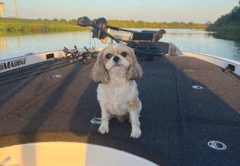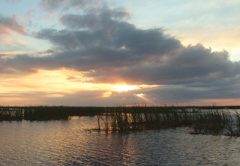OK let’s talk about where to go fishing. To get the year started let’s go right to the Gulf.
There are many species to be targeted in January such as grouper, snapper, king mackerel among others and most of them can be found at one spot not too far off the coast. It’s the old barge that is sunk 10.3 miles from Boca Pass.
When preparing yourself for a trip to the barge I would take two different types of rod and reel setups. The first would be a 30 size two speed conventional reel with a 6 foot rod, maybe a bit shorter and stout, with 65 to 80 pound test braid, a 6 ounce egg sinker, a swivel, 60 pound fluorocarbon leader, and a 7/0 circle hook on the business end. From the hook to the swivel I like about 3 feet of leader more or less. For the swivel I use a 150 pound test AFW Swivel in a dull finish.
I use a dull finish because I don’t want the flash of a shiny black or silver swivel attracting any toothy predators when I’m fighting the fish I’m trying to land. I put my egg sinker onto my main line before the swivel so the swivel keeps the weight from sliding down onto the hook which can interfere with my hookups.
For bait on this set up I like frozen Spanish sardines, they’re not too expensive and they really catch fish. I prefer Spanish sardines because they are a soft, stinky, oily, nasty bait which all fish like to eat. The one problem with Spanish sardines is that they are difficult to keep on the hook and tend to fall off if you are not really gentle. So I use a trick to keep them on the hook. I lay a whole squid on its side and then slice a cross section of it maybe ½ inch wide. The piece I cut when held up looks like a circle or thick rubber band. I then take that squid ring and pull it over the head of the sardine and the push the hook through the squid, through the sardine and through the other side of the squid ring. This creates a keeper for the bait and the tough skin of the squid will help the sardine to stay on the hook.
The second rod and reel combo is for snapper and for this I tend to use spinning tackle. This consists of a 50 or 60 size reel with a 6 to 6’6” rod, 30 or 40 pound test braided line, a 2 ounce sinker, a swivel, and again about 3 feet of 40 pound test fluoro-leader with a 2/0 circle hook. For bait all I put on is a chunk of squid which is usually all it takes. However I find that most fish prefer live shrimp but this offering is prone to attack from the bait stealers. So again I go back to the squid ring trick. Cut a thin slice of squid and put that on the hook, then put the live shrimp on the hook hooked through the head, and finally take the loose end of the squid strip and secure it to the hook locking in the shrimp’s head. The fish will whack the shrimp and maybe get away without being hooked but you’ll still have bait on your hook. So if you feel the bite and miss the fish, let it fall back down and wait. The fish will come back around for the squid which is still on your hook and tap-tap-tap, this time you got him.
I understand you can use the sardine without the squid collar, or just the shrimp without the squid back up, or just a squid alone, but when you first drop your bait into a new spot use a large bait like a full squid to see if any large fish are at the ready. For this I double hook the full squid through the pointy end allowing the tentacles to hang free. If there are no immediate strikes then you’ll begin to attract the smaller fish which are quicker and more aggressive. Once this occur switch out your full squid to a smaller bait and allow the smaller fish to begin a feeding frenzy. This burst of activity on the bottom will attract the bigger fish. Once the small fish action has heated up, slip back on a full squid, send it down and hold on for that monster bite.
As a parting thought, when I first approach my spot to bottom fish, I get close to the mark and then stop the boat. I then turn the wheel hard to the left and put the boat back into gear and slowly circle my spot watching the bottom machine for signs of structure. Once I mark a good structure or fish I toss a buoy over the back of the boat so I have a point to reference. Though a G.P.S. is good for getting you to the spot, it’s almost impossible to get back to the exact same spot, so the buoy gives you a reference point you can see. The next important point is where you anchor. In the Gulf missing the structure by a few feet might as well be a mile off, so if you can, anchor to your buoy and adjust your anchor line pay-out until you locate the fish. Once you’ve located the fish you can send down a more permeant anchor for a day’s fishing.
Good luck out there and I hope you enjoy this spot. The barge wreck is 10.3 miles off Boca on a heading of 226 degrees and it is in 48 feet of water. For your G.P.S the coordinates are 26-26.755N and 082-22.755W







